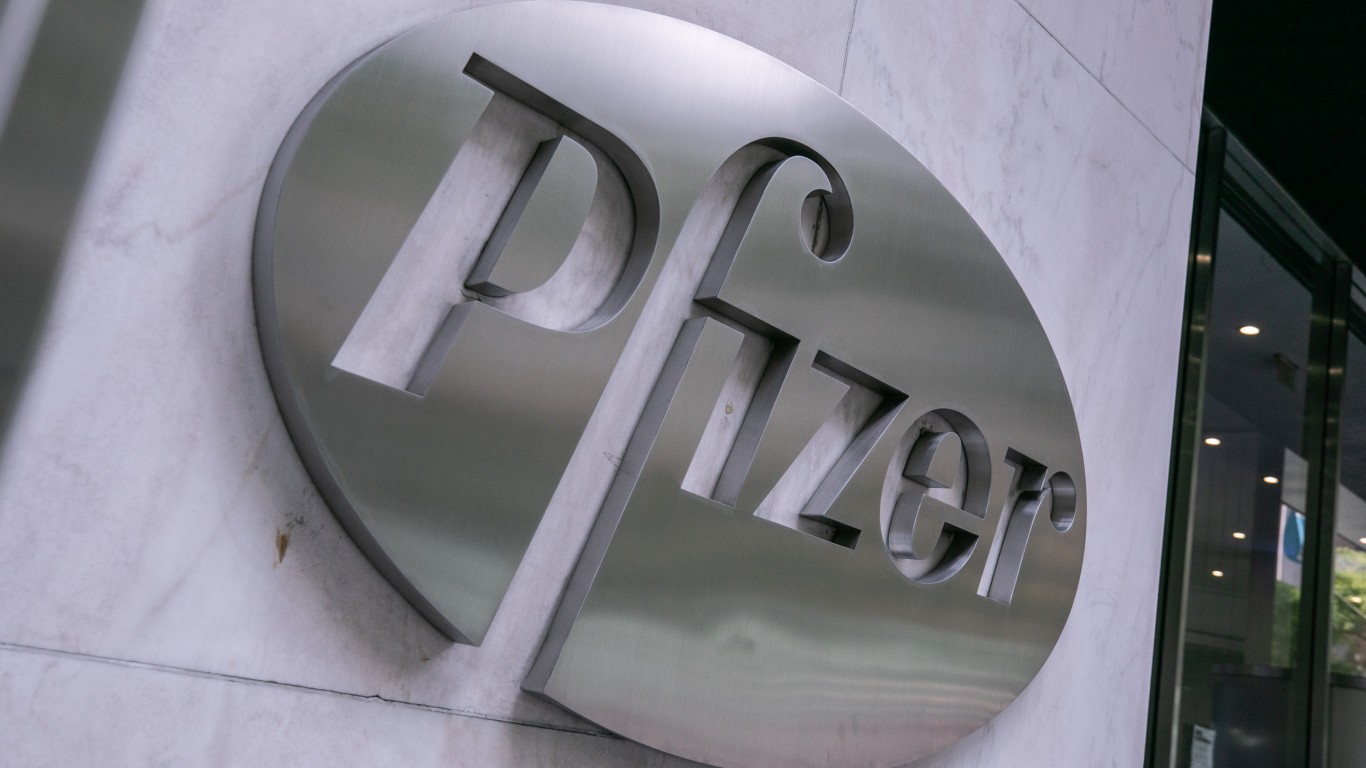
24/7 Wall St. Insights
- Eli Lilly and Co. (NYSE: LLY) is the clear frontrunner to be the largest pharmaceutical stock in 2034.
- What are its prospects for the next decade of growth?
- Also: 2 Dividend Legends to Hold Forever.
Pharmaceutical stocks are typically less affected by economic downturns than the broader market, making them appealing to investors looking to buy and hold. Despite ongoing concerns about drug pricing, the industry has tailwinds from strong growth and earnings due to medical advances, positive clinical trials, and new product launches. Industry trends include biologics, small molecule drugs, personalized medicine, additive manufacturing, and the use of artificial intelligence (AI).
Below are the likely contenders to be the largest pharmaceutical stock in 2034, based on market cap growth in the past decade.
| Stock | Market Cap Gain | Projected Market Cap |
| AbbVie Inc. (NYSE: ABBV) | 235.4% | $308.6 billion |
| AstraZeneca PLC (NASDAQ: AZN) | 121.6% | $201.9 billion |
| Eli Lilly and Co. (NYSE: LLY) | 1,269.0% | $992.5 billion |
| Novo Nordisk A/S (NYSE: NVO) | 468.2% | $751.1 billion |
Clearly, Lilly is the frontrunner. It already is the largest public pharmaceutical company, and it is projected to be the first health care company to reach a $1 trillion valuation. The question is whether it can keep up the momentum over the next 10 years.
Why Invest in Eli Lilly?

Lilly stock is about 1,269% higher than it was 10 years ago. Shares were last seen trading above $905 apiece. They hit an all-time high near $972 a share last month.
The company claims to work every day with a goal of growing its business in responsible and sustainable ways that better people’s lives and benefit society. It is committed to expanding equitable access to medicines for more people around the world, and it is working to improve public health for vulnerable people living in areas with limited resources. Lilly also says it aims to source 100% of its purchased electricity from renewable sources and to achieve carbon neutrality in its operations by 2030.
Its dividend yield is just 0.6%, but note that the payout has increased every year for the past decade. Let’s take a look at the company’s prospects and what Wall Street expects from the stock.
The Company

The company discovers, develops, and markets human pharmaceuticals worldwide, including polio vaccine and insulin. Among its best-known products now are Cialis, Cymbalta, Humalog, Jardiance, Olumiant, Prozac, Trulicity, and Zyprexa.
The company operates Lilly Seaport Innovation Center, a research and development facility in the Boston Seaport to advance Eli Lilly’s efforts in RNA and DNA-based therapies. The company has collaborations with Incyte, Boehringer Ingelheim Pharmaceuticals, F. Hoffmann-La Roche and Genentech, Biologics, AbCellera Biologics, and others.
Lilly headquarters are in Indianapolis. The company was founded in 1876 by Colonel Eli Lilly, a pharmaceutical chemist and Union Army veteran of the American Civil War. It became a publicly traded company in 1952. The company competes with or is similar to Bristol-Myers Squibb Co. (NYSE: BMY), GSK PLC (NYSE: GSK), Merck & Co. Inc. (NYSE: MRK), and Pfizer Inc. (NYSE: PFE).
The company has received the FDA nod for its eczema treatment. Recently it announced a $1.8 billion investment to ramp up output in Ireland, and it named a new chief financial officer. In addition, investors are watching for a potential stock split.
The Company’s Prospects

A 24/7 Wall St. analysis revealed that the company has a very solid foundation for future growth. First, its innovative pipeline includes several very high-potential medications, including some with blockbuster potential. Also contributing handily to the company’s growth were more than a dozen acquisitions of mid-sized companies with promising pipelines in the past few years. And then there is its sound balance sheet and operational efficiency that allows Lilly to manage costs.
Another point in Lilly’s favor going forward will be AI, which in the coming years will help pharmaceutical businesses process larger amounts of data more efficiently in clinical trials. AI is expected to play an important role in drug discovery and identifying diseases and illnesses well before they become a problem. Lilly positioned itself for that with a partnership with OpenAI.
The Stock

Since the beginning of the year, the share price has gained more than 55%, while the S&P 500 is up about 18% in that time. In the past two years, Lilly stock is over 193% higher, and the S&P 500 has gained 45% or so. Analysts see shares rising 11.0% in the next year to their mean price target of $1,003.35. That would be an all-time high. 24/7 Wall St. projected a 100% increase in the share price by 2030. The consensus recommendation of analysts has been to buy shares for at least four months. Cantor Fitzgerald, J.P. Morgan, and Morgan Stanley all recently reiterated Overweight ratings recently.
Institutional investors hold more than 83% of the shares. BlackRock, Vanguard, and PNC Financial Services have notable stakes. Almost 852 million shares, or less than 1% of the float, are held short. Note that the Lilly Endowment, a beneficial owner, has sold almost $50 million worth of shares in the past six weeks.
Is Eli Lilly a Stock to Buy and Hold Forever?
The Average American Has No Idea How Much Money You Can Make Today (Sponsor)
The last few years made people forget how much banks and CD’s can pay. Meanwhile, interest rates have spiked and many can afford to pay you much more, but most are keeping yields low and hoping you won’t notice.
But there is good news. To win qualified customers, some accounts are paying almost 10x the national average! That’s an incredible way to keep your money safe and earn more at the same time. Our top pick for high yield savings accounts includes other benefits as well. You can earn up to 3.80% with a Checking & Savings Account today Sign up and get up to $300 with direct deposit. No account fees. FDIC Insured.
Click here to see how much more you could be earning on your savings today. It takes just a few minutes to open an account to make your money work for you.
Our top pick for high yield savings accounts includes other benefits as well. You can earn up to 4.00% with a Checking & Savings Account from Sofi. Sign up and get up to $300 with direct deposit. No account fees. FDIC Insured.
Thank you for reading! Have some feedback for us?
Contact the 24/7 Wall St. editorial team.





